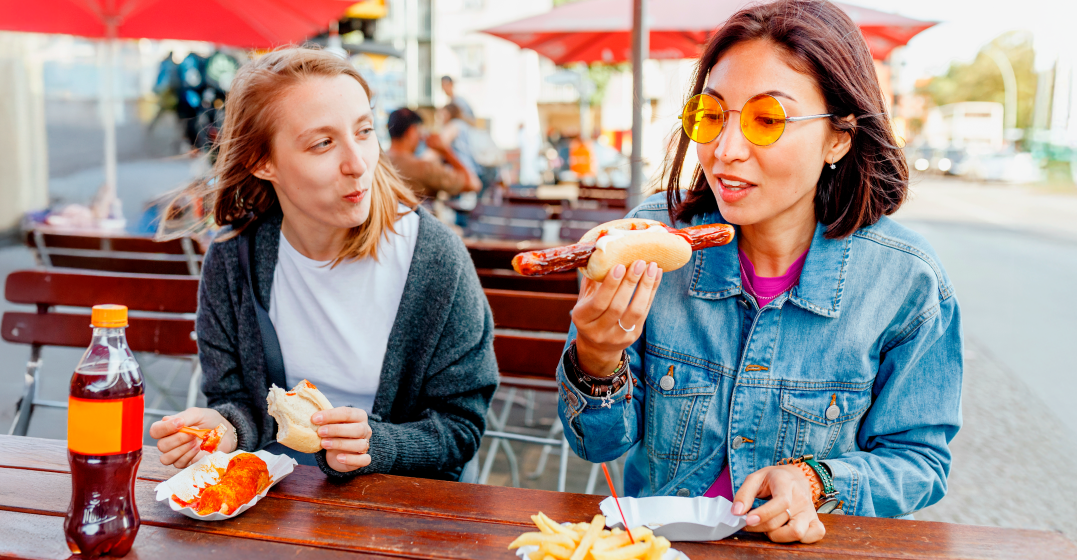German food vocabulary: Essential words for German learners
Food is not only an essential part of our everyday life — it’s also an important aspect of our language. As a German-language learner, being able to converse about food in German helps you navigate mundane tasks like going to the supermarket. But it also opens new and perhaps unexpected doors to German culture itself.

In the following guide, we’ve compiled the most important German food vocabulary. You’ll learn basic phrases about food in German, as well as in-depth vocabulary about German food items. Are you feeling hungry already? Let’s talk food in German!
- Common German words for “food”
- Basic German food vocabulary
- German cuisine essentials
- How to talk about food in German
- Unique linguistic quirks about food in German
- Practical tips for learning German food vocabulary
Common German words for ‘food’
Before we can start talking about bratwurst, pretzels and other yummy dishes, it’s important to know the German words used to describe food in general. You’ll probably hear people use different expressions for food, depending on the context. Common German words for food include das Essen, die Speise, die Mahlzeit and die Lebensmittel.
Here’s how to differentiate between them and how to use them in conversations:
| Word | Meaning | How to use it | Examples |
| das Essen | Food, meal, dish | You can use das Essen as an umbrella term for every dish, meal and prepared or unprepared item of food. | Hat dir das Essen geschmeckt? (Did you like the food?) Welches Essen magst du am liebsten? (What is your favourite food/dish?) Es gibt jetzt Essen. (The meal is ready now.) |
| das Gericht | dish | Das Gericht is commonly used for prepared food. Look out for the context on this one, because the word can also mean “court” in German. | Sie haben viele Gerichte zur Auswahl. (They have many dishes to choose from.) Welches Gericht wirst du bestellen? (Which dish are you going to order?) |
| die Speise | dish | Die Speise is used for food that has already been prepared, such as snacks or full meals. Although you’ll hear people use Speise sometimes, it sounds very formal and is a more traditional term for food. | Diese Speise ist zu salzig. (This dish is too salty.) |
| die Mahlzeit | meal, dish, mealtime, repast | When someone talks about a Mahlzeit, they’re referring to one of the (typically three) meals of the day: breakfast, lunch or dinner. In southern Germany, people will also use “Mahlzeit!” to wish others a good meal. | Hast du heute eine Mahlzeit ausgelassen? (Did you miss one of the meals today?) Frühstück, Mittagessen und Abendessen sind Mahlzeiten. (Breakfast, lunch, and dinner are mealtimes.) Sie bieten verschiedene Mahlzeiten an. (They offer different meals.) |
| die Lebensmittel | groceries | When someone talks about Lebensmittel, they’re usually referring to groceries or food items. The expression is mostly used to refer to more than one item of food. | Wir müssen Lebensmittel einkaufen gehen. (We have to go buy groceries.) Welche Lebensmittel brauchen wir? (What kind of groceries do we need?) |
| die Nahrung | Nourishment, nutrition | This word is mostly used in a scientific or nutritional context. | Gras ist Nahrung für Kühe. (Gras is nutrition for cows.) |
| der Proviant | Supplies, i.e. food you pack for a hike or on the way | The expression is still used, but mostly in the context of hiking. Sometimes, it’s referred to jokingly — if you’re packing a sandwich for a five-minute walk, for example. | Wir müssen noch Proviant besorgen. (We still have to get supplies.) |
| das Mahl | meal | This word sounds a bit antiquated and it’s not really used in everyday life. You’d more commonly see das Essen. | Das war ein gutes Mahl. (That was a good meal.) |
German food vocabulary can differ depending on the region, so it helps to learn German from someone who’s from or lives in the region you want to explore At Lingoda, you can learn German from native-level speakers who know all about these different language varieties and cultural differences.

Learn German with Lingoda
How it works

Basic German food vocabulary
Let’s start with the basic words and phrases you need to know to talk about food in German. Think about it as ordering the starter for your language meal.
Basic words and phrases
Let’s go to a restaurant together! Here are the basic words you need to know to order food in German:
| das Essen | the food |
| die Speisekarte | the menu |
| das Getränk | the drink |
| das Gericht | the dish |
| etwas zu essen | something to eat |
| der Snack | the snack |
| der Hunger | the hunger |
| der Durst | the thirst |
| das Restaurant | the restaurant |
| der Supermarkt | the supermarket |
| das Lebensmittelgeschäft | the grocery |
| der Geschmack | the taste |
| Guten Appetit! | Enjoy your meal! |
| Ich hätte gern… | I’d like to have… |
Foods and ingredients
If you want to go shopping, you’ll need to know how to talk about German food items. In the following, we’ve listed the most common recipe ingredients — from fruits and vegetables to proteins and starches.
Fruits in German
| die Früchte | the fruits |
| der Apfel | the apple |
| die Banane | the banana |
| die Birne | the pear |
| die Zitrone | the lemon |
| die Limone | the lime |
| die Trauben | the grapes |
| die Aprikose | the apricot |
| die Kiwi | the kiwi |
| die Ananas | the pineapple |
| die Erdbeere | the strawberry |
| die Blaubeere | the blueberry |
| die Brombeere | the blackberry |
| die Himbeere | the raspberry |
| die Orange | the orange |
| die Zwetschke | the plum |
| die Melone | the melon |
| der Pfirsich | the peach |
German vegetables
| das Gemüse | the vegetables |
| die Gurke | the cucumber |
| der Salat | the salad |
| die Tomate | the tomato |
| die Paprika | the bell pepper |
| die Zucchini | the zucchini |
| die Aubergine | the eggplant |
| die Karotte/die Möhre | the carrot |
| der Sellerie | the celery |
| die Bohne | the bean |
| der Blumenkohl | the cauliflower |
| der Brokkoli | the broccoli |
| der Rosenkohl | the sprout |
| der Spinat | the spinach |
| der Lauch | the leek |
| die Erbse | the pea |
| der Kürbis | the pumpkin |
Proteins in German: Meats, fish and vegan/vegetarian alternatives
| das Fleisch | the meat |
| der Fisch | the fish |
| die Pute | the turkey |
| das Huhn | the chicken |
| das Rindfleisch | the beef |
| das Schweinefleisch | the pork |
| das Steak | the steak |
| die Wurst/das Würstchen | the sausage |
| das Hackfleisch | the ground meat |
| das Schnitzel | the schnitzel |
| das Filet | the filet |
| die Garnele | the prawn |
| der Tintenfisch | the squid |
| die Forelle | the trout |
| der Dorsch | the cod |
| der Hummer | the lobster |
| die Muscheln | the mussel |
| das Tofu | the tofu |
| das Seitan | the seitan |
| das Tempeh | the tempeh |
| das Fleischersatzprodukt | the meat substitute |
Grains and starches in German
| das Getreide | the grain |
| der Reis | the rice |
| die Nudeln | the pasta |
| das Brot | the bread |
| der Mais | the corn |
| der Couscous | the couscous |
| der Quinoa | the quinoa |
| der Roggen | the rye |
| der Weizen | the wheat |
| die Haferflocken | the oats |
| die Linsen | the lentils |
| die Kichererbsen | the chickpeas |
| die Bohnen | the beans |
| die Gerste | the barley |
Beverages in German
The most famous German drink? Beer, of course! However, as you can’t survive on beer alone, we’ve listed a few more to help you stay hydrated. Prost!
| das Getränk | the drink |
| das Wasser | the water |
| der Kaffee | the coffee |
| der Tee | the tea |
| die heiße Schokolade | the hot chocolate |
| der Saft | the juice |
| die Saftschorle | Mixture of fruit juice and (usually sparkling) water |
| die Limonade | the lemonade |
| die Cola | the cola |
| der Wein | the wine |
| das Bier | the beer |
| der Schnaps | the hard liquor |
German cuisine essentials
Now that we’ve learned the different names for foods and ingredients in German, we can move on to German cuisine. From Bratwurst to Kartoffelpuffer and Brezeln, it’s time to go to a German restaurant and try our top German dishes!
Vocabulary for iconic German dishes
| die Bratwurst | the bratwurst (a grilled sausage) |
| das Schnitzel | the cutlet (breaded and fried meat) |
| die Kartoffelpuffer | the potato pancakes |
| die Maultaschen | a kind of pasta stuffed with meat and vegetables |
| der Stollen | the fruitcake |
| der Kaiserschmarrn | cut-up and sugared pancakes with raisins (often enjoyed with applesauce) |
| der Krapfen/Berliner/Kreppel | doughnut with different fillings, like jelly or vanilla pudding |
| die Brezel | the (soft) pretzel |
| der Senf | the mustard |
| der Schweinebraten | the roast pork |
| die Schweinshaxe | the knuckle of pork |
| die Knödel | the dumplings (made from potatoes or stale bread) |
| die Currywurst | the sausage (topped with curry ketchup) |
| die Schwarzwälder Kirschtorte | the Black Forest cherry tart |
| die Spätzle | spaetzle (traditional German food from the South, made by boiling small lumps of dough) |
| die Käsepätzle | spaetzle with melted cheese and onions |
| der Leberkäse | a type of meatloaf popular in Germany and Austria, often enjoyed in a roll |
Typical German mealtimes
Typically, three meals are eaten throughout the day in Germany. Even though a lot of Germans have moved away from the traditional mealtimes and not everyone follows a strict routine, for many, a day would be structured as follows:
- Breakfast around 8–9 a.m.
- Lunch at 12 p.m.
- Dinner around 6 p.m.
German breakfast is usually cold and consists of bread, muesli and, if you’re feeling fancy, an egg. Lunch used to be the big meal of the day and was served hot, but this has changed for many people due to their work schedules. These days, many working Germans simply grab something small like a sandwich or a salad at noon and eat something warm in the evening when there’s enough time to cook or go to a restaurant.
| das Frühstück | the breakfast |
| das Mittagessen | the lunch |
| das Abendessen | the dinner |
| die Zwischenmahlzeit/der Snack | the snack |
How to talk about food in German
Being able to talk about the taste and texture of food is important. How else are you supposed to express how delicious the cake at the small bakery around the corner really is?
Describing taste and preferences
| der Geschmack | the taste |
| schmecken | to taste |
| süß | sweet |
| sauer | sour |
| salzig | salty |
| bitter | bitter |
| umami | umami |
| scharf | hot |
| herzhaft | hearty |
| fruchtig | fruity |
| würzig | savoury |
| säuerlich | slightly sour |
| süßlich | slightly sweet |
Food also makes for great small talk when you’re meeting German speakers. These are the most important phrases about taste that you need to know:
| Das schmeckt gut! | That tastes good! |
| Was isst du gern? | What do you like to eat? |
| Ich mag am liebsten… | I like … the most. |
| Was ist dein Lieblingsessen? | What is your favorite meal? |
| Das ist lecker! | That’s tasty! |
| Das ist köstlich! | That’s delicious! |
Unique linguistic quirks about food in German
If you’ve already spent some time in a German-speaking country, you may have witnessed a dispute between people from different German regions about the correct name of a food item. A famous example: the doughnuts often served at Carnival, which are called Kreppel in Hessen, Krapfen in the South, Pfannkuchen in Berlin and Berliner in the West.
As you might know, German is famous for its compound nouns, i.e. long words consisting of numerous nouns. One food-related compound noun is Lebensmittelgeschäft (grocery shop) which would simply be “grocery” in English. Another common one is Speisekarte (meal card), which translates to “menu.”
Practical tips for learning German food vocabulary
There’s a lot of great German food to choose from, and even more words to describe it.
The best way to learn German food vocabulary is to use flashcards. Try to practice a few minutes each day. Continuity goes a long way when you’re trying to learn a new language, and you don’t always have to invest hours to make progress. A great way to make it easier to remember the words is to incorporate visual images into your flashcards.
Most importantly, you should try to actively use the words you’ve learned. While mustering up the courage to speak can be hard, especially for beginners, it’s necessary if you want to be able to use your knowledge in the real world.
Training in a safe environment can help you on your way to mastering German. That’s why language classes at Lingoda focus on speaking German. In small groups, you’ll get enough time to practice at your own pace and ask questions.
Also, actually trying the food you’re learning about will make a real difference. Who said that learning vocabulary can’t be a great experience for your taste buds as well?
Learning about food in German: Vocabulary practice as your daily bread
If you want to learn about food in German, starting with the basics is the best way to go about it. There’s always something new to discover when it comes to food, but in order to remember all the vocabulary about German food items and phrases around food, repetition is necessary. The good news is that practicing vocabulary for just a few minutes each day can make a huge difference.
When learning a new language, it’s important to use the words you’ve learned, so as not to forget them or freeze in the midst of a real-life conversation. Practicing in a small group in a German course at Lingoda can help you get comfortable speaking German. As the classes are available 24/7, you can easily find time to learn German online when it fits your schedule.

Learn German with Lingoda
How it works

















